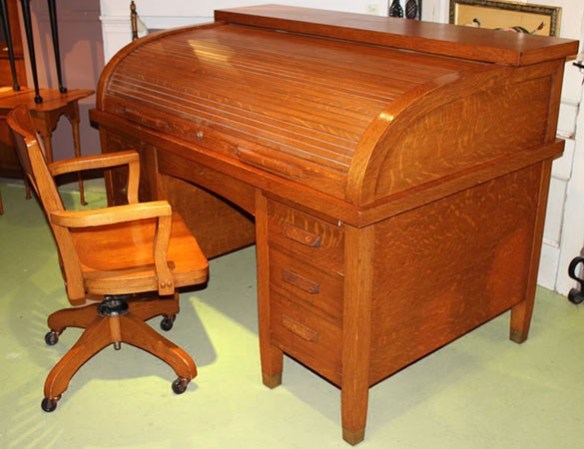
In the breakfast room of my grandparents’ house was Bampaw’s wooden Roll-top Desk, an item a little smaller than a Chevy coupe. Filled with cubby holes, smelling of tobacco, ink, old paper, and lighter fluid, it was Bampaw’s safe and command central. The objects inside were Very Important and Not To Be Touched. Of course, this made the desk a kid-magnet.
Until I was 6, we lived with my grandparents. My granddad, Bampaw, spent most of his household time in the breakfast room, the sunniest in the house and also close to the kitchen, where beer lived in the refrigerator.
In addition to the roll-top desk and later addition of Polly the parrot, there was the misnamed breakfast table, where we ate all our non-holiday meals. It was at this table that most family activities occurred: mail reading, dress pattern cuttings, snacks, newspaper reading, Chinese Checkers, crossword puzzle solving, snacks, art projects, hand sewing, small household repairs, games of solitaire, and snacks.
Long before any books about where to place yourself in a room to command a group meeting, Bampaw had chosen his spot at the breakfast table. From there, he’d read some newspaper articles aloud. From his Bantam Rooster seat, he’d pour the first dollops of his coffee into his saucer to sip as it cooled, with noisy slurps. From there he commanded the best view of his territory: to the street corner and side porch out one window and all along the side street from a second set. One step and he was at his desk.
There he kept pipe cleaners and abandoned pipes, legal papers, stamps and stationery, stamp pads, “rare” coins, and an elaborate set of poker chips. There I kept my imaginings.
Snuggled into its kneehole, I was hiding below decks on a Spanish galleon – a stowaway kid who would soon find the buried treasure that eluded the colorful but stupid pirates. Or I was the shackled prisoner in the castle dungeon, plotting my revenge. Scooting around to its side, I could settle down to defend the fort from the attacking Indians or Yankees.
Bampaw was very clear that this was HIS desk. I couldn’t go inside without his permission. Little fear there: even if he didn’t lock the drawers and top, I couldn’t possibly lift its heavy, corrugated roll-top. Even he took 2 heaves to get it all the way open. The top slammed into place like a car door – whang! Bampaw also did a good job of describing severed little girl fingers if the top fell.
But I could play on the open desktop if Bampaw was reading the paper or playing solitaire in the room. Kneeling on a chair, I could see over the desk ledge, play jacks or building blocks. Just so long as I muted my sound effects and/or humming. I would build the interior of my castle so as to create a puzzle, a maze. That way the King and his bodyguard knights could lie in wait for the Yankees and not be seen.
I could never get Bampaw to join in Castle Blocks. I would explain how he needed to try and get through my puzzle. He could even be the King and I would be the Indians (I’d NEVER be the Yankees). I would attempt the magic phrase that Mammaw successfully used on him: “It’ll only take a minute!” Never worked. He’d just stare back at me over his glasses, raise his caterpillar eyebrows and go back to his paper.
He knew the special treat, though. Sometimes he would open the Most Wonderful Treasure for me, his poker chips box. These were heavy, large, old-fashioned Bakelite disks with milled edges, in marbled colors: deep red, dark blue, dark green and ivory. They lived in a felt-lined box in stacks on their sides, sleeping. Bampaw would lift them out for me to prevent grimy finger smudges on the felt. They were the perfect doubloons, made a terrific clattering noise when gathered up and let run through the fingers. When stacked exactly, the milled edges snapped together.with a click. There weren’t enough of each color for me build individual castles, but there were endless combinations of colors to use to make one big structure. When licked, they tasted like old tobacco.
I was never able to place all of them in one big stack, despite repeated attempts. Which always ended the chips playtime. Bampaw was unreasonably sure that having the floor covered in chips would lead to a chip loss and I would have to count as high as I could to convince him we had them all back.
Being a sneaky, underhanded kid, I naturally looked for the opportunity to play inside the desktop – Mt. Everest of possibilities. One day it happened. Bampaw forgot to close the roll-top desk. He now was at work. Mom was at work. Mammaw was out doing errands. The only one home was Irene, our occasional help. Here was my big chance! Ohboyohboyohboy. My only obstacle was eagle-eyed Irene.
Now, Irene had unfortunately missed her true calling of Marine drill sergeant. She did have her Rules and you followed them “or else”. I had spent quite some time closed in the room I shared with my mom when I had merely not sufficiently modulated my voice.
Luckily in this case, Irene never wanted me “spying” on her at work, hanging around. I did have to regularly sound out from where ever I was to let her know I wasn’t Up to Something. She’d call out “WhaChooUpTo?!!” and I was supposed to answer “Picture books!” or “Drawing!” I had learned never to say “Nothing!”, as she correctly would realize that that meant Something. The only time I had a break from this radar-monitoring was during Vacuum Time.
Irene would get into a vacuuming rhythm and not turn the machine off for quite a while. If I could listen for the vacuum, I’d be safe to explore the desk. So left my crayon work on the breakfast table, pulled over the chair and climbed up! Wow! What a view! I could see all the way out the windows to across the street. Land ho, me hearties! I rule the seas from this pirate ship’s deck, haha! Raise that main sail! Catch that treasure ship. The desk’s surface made a satisfying creak – just like a ship – when I shifted my weight, hands on hips, a dagger between my teeth. I dodged some cannonballs and hid in the curve of the desk sides. Nyaah, nyaah, ya missed me, Capt. Hook! The vacuum stopped. Irene did her call and I answered “Drawing!” Vacuum started up again.
Next to the kitchen on the back porch was the fishing kit I used in the inflatable wading pool of the kid next door. There was a short rod with a blunt hook and a few flat, plastic fishes of different colors that you could catch. I then sat dangling my feet off the desk edge dock, catching a meal for my crew. I was a good pirate captain. Then I heard our car pulling up the driveway. Mammaw was home! I abandoned ship.
A few days later, I was at the breakfast table when Bampaw moved a pile of papers on his desk. Frowning, he swiveled around and held up a blue plastic fish. “What is THIS, young lady?” Fortunately, he had read a funny column out loud about fishing only that morning. I blurted out “The one that got away?” He hooted loud as could be and laughed himself into a coughing fit.
Decades later, widower Bampaw married a Cuban widow acquaintance, Mary. During my first visit with them, she and I were rearranging the breakfast room. She asked me to move a small table, but I couldn’t be sure of what she’d said. She repeated “Over there. By the fishing desk.”
 In the late 1950s, Montgomery, Alabama was filled with scores of Early American, Antebellum, Late Victorian, Sears Modern, plain Hand-Me-Down furniture. Across the city, far as the eye could see, all those living rooms and dining rooms were filled with such. Crocheted antimacassars, overstuffed sofas, electrified ersatz gas lamps, sleek hi-fi consoles, flying-saucer-inspired light fixtures were accompanied by looming display cabinets containing the family’s heirloom china.
In the late 1950s, Montgomery, Alabama was filled with scores of Early American, Antebellum, Late Victorian, Sears Modern, plain Hand-Me-Down furniture. Across the city, far as the eye could see, all those living rooms and dining rooms were filled with such. Crocheted antimacassars, overstuffed sofas, electrified ersatz gas lamps, sleek hi-fi consoles, flying-saucer-inspired light fixtures were accompanied by looming display cabinets containing the family’s heirloom china. In high school, Annette began painting Asian figurines to be sold in furniture stores. They sold quite well and the furniture stores kept her constantly supplied with unpainted blanks. Several Halloweens she dressed as a geisha. At least a Montgomery version of a geisha…
In high school, Annette began painting Asian figurines to be sold in furniture stores. They sold quite well and the furniture stores kept her constantly supplied with unpainted blanks. Several Halloweens she dressed as a geisha. At least a Montgomery version of a geisha…

 THE FURTHER FATTENING ADVENTURES of PUDGE GIRL BLIMP
THE FURTHER FATTENING ADVENTURES of PUDGE GIRL BLIMP